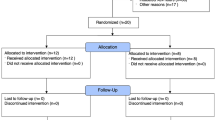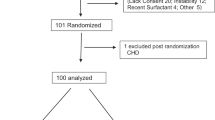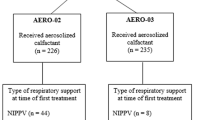Abstract
OBJECTIVE: To compare immediate changes in lung compliance following the administration of two commercially available natural surfactants.
METHOD: We conducted a prospective, randomized study of 40 preterm infants with respiratory distress syndrome requiring surfactant. Infants received either Infasurf® or Survanta®. The primary outcome measure was the change in compliance assessed by bedside pulmonary monitoring.
RESULTS: There were no significant changes in dynamic lung compliance within or between the two groups 1 hour after surfactant administration. However, infants given Survanta required more doses per patient (4 vs 2, p=0.05) and were more likely to require >2 doses (57 vs 26%, p=0.05). Infants requiring >1 dose of surfactant had a greater change in airway pressure and improved oxygenation just before the second dose when treated with Infasurf.
CONCLUSIONS: We found no significant difference in acute changes in lung compliance. However, treatment with Infasurf seems to be more long lasting than Survanta.
This is a preview of subscription content, access via your institution
Access options
Subscribe to this journal
Receive 12 print issues and online access
$259.00 per year
only $21.58 per issue
Buy this article
- Purchase on Springer Link
- Instant access to full article PDF
Prices may be subject to local taxes which are calculated during checkout

Similar content being viewed by others
References
Surfactant replacement therapy for respiratory distress syndrome. American Academy of Pediatrics. Committee on Fetus and Newborn. Pediatrics 1999;103:684–685.
Notter RH, Wang Z, Egan EA, Holm BA . Component-specific surface and physiological activity in bovine-derived lung surfactants. Chem Phys Lipids 2002;114:21–34.
Mizuno K, Ikegami M, Chen CM, Ueda T, Jobe AH . Surfactant protein-B supplementation improves in vivo function of a modified natural surfactant. Pediatr Res 1995;37:271–276.
Cummings JJ, Holm BA, Hudak ML, Hudak BB, Ferguson WH, Egan EA . A controlled clinical comparison of four different surfactant preparations in surfactant-deficient preterm lambs. Am Rev Respir Dis 1992;145:999–1004.
Bloom BT, Kattwinkel J, Hall RT, et al. Comparison of Infasurf (calf lung surfactant extract) to Survanta (Beractant) in the treatment and prevention of respiratory distress syndrome. Pediatrics 1997;100:31–38.
Attar MA, Donn SM . Mechanisms of ventilator-induced lung injury in premature infants. Semin Neonatol 2002;7:353–360.
Ikegami M, Agata Y, Elkady T, Hallman M, Berry D, Jobe A . Comparison of four surfactants: in vitro surface properties and responses of preterm lambs to treatment at birth. Pediatrics 1987;79:38–46.
Bhutani VK, Abbasi S, Long WA, Gerdes JS . Pulmonary mechanics and energetics in preterm infants who had respiratory distress syndrome treated with synthetic surfactant. J Pediatr 1992;120:S18–24.
Bhat R, Dziedzic K, Bhutani VK, Vidyasagar D . Effect of single dose surfactant on pulmonary function. Crit Care Med 1990;18:590–595.
Couser RJ, Ferrara TB, Ebert J, Hoekstra RE, Fangman JJ . Effects of exogenous surfactant therapy on dynamic compliance during mechanical breathing in preterm infants with hyaline membrane disease. J Pediatr 1990;116:119–124.
Davis JM, Veness-Meehan K, Notter RH, Bhutani VK, Kendig JW, Shapiro DL . Changes in pulmonary mechanics after the administration of surfactant to infants with respiratory distress syndrome. N Engl J Med 1988;319:476–479.
Khoury MJ, Marks JS, McCarthy BJ, Zaro SM . Factors affecting the sex differential in neonatal mortality: the role of respiratory distress syndrome. Am J Obstetr Gynecol 1985;151:777–782.
Ingemarsson I . Gender aspects of preterm birth. BJOG Int J Obstetr Gynaecol 2003;110:34–38.
Lemons JA, Bauer CR, Oh W, et al. Very low birth weight outcomes of the National Institute of Child health and human development neonatal research network, January 1995 through December 1996. NICHD Neonatal Research Network. Pediatrics 2001;107:E1.
Walsh MC, Wilson-Costello D, Zadell A, Newman N, Fanaroff A . Safety, reliability, and validity of a physiologic definition of bronchopulmonary dysplasia. J Perinatol 2003;23:451–456.
Author information
Authors and Affiliations
Rights and permissions
About this article
Cite this article
Attar, M., Becker, M., Dechert, R. et al. Immediate Changes in Lung Compliance Following Natural Surfactant Administration in Premature Infants with Respiratory Distress Syndrome: a Controlled Trial. J Perinatol 24, 626–630 (2004). https://doi.org/10.1038/sj.jp.7211160
Published:
Issue Date:
DOI: https://doi.org/10.1038/sj.jp.7211160
This article is cited by
-
Comparative efficacy and safety of late surfactant preparations: a retrospective study
Journal of Perinatology (2021)
-
Response to Cummings
Journal of Perinatology (2013)
-
What’s new in surfactant?
European Journal of Pediatrics (2007)



